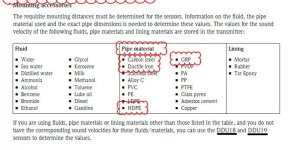dear,
i was looking at the ultrasonic flowmeter from E+H, proline prosonic flow 93W, this flowmeter will be used for sewage applications, and the sewage as fluid and the lining are not indicated in the attached (att#1)
Do i need to order DDU18 for measuring the required sound velocities and DDU19 for measuring the required wall thickness for getting the proper values to configure this flowmeter? and how this is usually done?, are the measurements from DDU18/DDU19 used only one time and the result is input in the device?... please advice.
thanks a lot!
charbel

i was looking at the ultrasonic flowmeter from E+H, proline prosonic flow 93W, this flowmeter will be used for sewage applications, and the sewage as fluid and the lining are not indicated in the attached (att#1)
Do i need to order DDU18 for measuring the required sound velocities and DDU19 for measuring the required wall thickness for getting the proper values to configure this flowmeter? and how this is usually done?, are the measurements from DDU18/DDU19 used only one time and the result is input in the device?... please advice.
thanks a lot!
charbel




